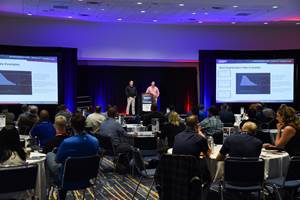SPI Machinery and Moldmakers Divisions Work to Address the Need For Mold Safety Standards
Throughout the world, injection molding machine (IMM) operators work with high-temperature plastics, high injection pressures, powerful clamping and ejection forces and rapidly moving steel masses.
Throughout the world, injection molding machine (IMM) operators work with high-temperature plastics, high injection pressures, powerful clamping and ejection forces and rapidly moving steel masses. Though these would seem to present a potential for injury, today's workers enjoy many safeguards against the potential hazards associated with machine operation. These safe-guards are the result of IMMs that are manufactured and used in accordance with today's safety standards, such as ANSI/SPI B151.1-1997.
These IMM safety standards are the result of the collaborative efforts of manufacturers and molders to:
1) identify potential hazards relating to IMM operation and use, and
2) develop performance criteria for safeguards to protect workers from those potential hazards.
In North America, the Society of the Plastics Industry, Inc. (SPI) plays a key role as a coordinator of such activities.
SPI believes this same sort of collaboration should be applied to the development of a mold safety standard.
Background
IMMs that comply with the ANSI/SPI B151.1-1997 safety standard have multiple safety systems that protect operators from potential mold area hazards, such as platen closing motion and machine ejector action. Though the IMM clamp is prevented from closing by multiple interlocks, the mold-ejection system, which could include springs or motions powered independently from the IMM, may create pinch points with the IMM gate open. Also, as the mold is sometimes operated at high temperatures, access to hot mold surfaces could cause serious burns. In response to these concerns, the moldmakers of North America, under the coordination of SPI, have established a mold safety committee to develop an ANSI safety standard for the integration, care and use of molds used with IMMs.
In developing this standard, the moldmakers face a challenge that is unique to their industry. This challenge is that no mold safety standard now exists. Thus, this mold standard must be developed without the benefit of experience from previous standards. By contrast, the IMM manufacturers and molders have a long tradition of safety standards for IMMs, with the first one being published in 1976.
Unlike the IMM industry, the moldmaking industry is made up of many small companies, which makes SPI's task of achieving communication, organization and consensus for a safety standard much more difficult. However, SPI has accepted these challenges and has taken the lead in this effort, as it did in the creation of the IMM standards.
Safety Issues
The following are some of the mold safety issues that the SPI mold safety committee will be addressing in developing this standard:
- Mold Mounted Guards: In the event a mold has components that could be potentially hazardous when the machine's operator gate is open or has components that extend beyond the guarding of the machine, guarding attached to the mold may be required to prevent injury.
- Interlocking Mold Motion: Many molds use hydraulic or pneumatic cylinders to move mold elements. These may be independent of the machine control. If these mold elements are energized when the operator gate is open, potential pinch points may result.
- Mold Electrical Safety: Many molds, particularly those with hot runners or hot sprues, use electrical power supplied either by the IMM or by a separate controller. This power can be substantial and very often is located in a high-temperature area of the mold, which could result in a high-temperature and/or high-voltage hazard.
- Mold Mounting and Handling: Practices and devices for safe lifting, handling and storing of the assembled mold and mold sub-assemblies will be addressed.
- Warning Signs and Instructions: Where potential mold hazards cannot be eliminated by design, effective warning signs and instructions are needed.
SPI Takes Action
To address safety issues surrounding proper usage of molds, SPI has established a committee to develop an "American National Standard for Molds Used with Horizontal Injection Molding Machines - Safety Requirements for the Integration, Care and Use."
The standard's objective will be to minimize hazards to personnel associated with mold activity by establishing recommendations for the manufacture, care and use of molds. To accomplish this goal, the SPI Machinery and Moldmakers Divisions' Standards Development Committee decided to approach mold safety from two directions:
- Eliminating recognized hazards and establishing standard approaches to design so that molds available from competitive manufacturers will have similar safety features, and
- Safeguarding personnel from recognized mold hazards.
Acknowledging the impossibility of updating equipment and changing operational methods associated with existing molds immediately after the approval date of this standard, a grace period will be provided to employers for updating existing molds. Likewise, recognizing the impossibility of immediate updating of design and manufacturing methods, the Manufacture, Remanufacture and Modification and the Safety Signs clauses would become effective one year after the approval date of this standard.
The standard is based upon the following facts:
- Molds are an essential element in the production of plastic parts and goods.
- They are installed in horizontal molding machines.
- They are complicated instruments with moving parts and mechanisms.
- They require trained, skilled operators/technicians.
- They can be large and extremely heavy.
- There are numerous safety considerations for molds, including electrical, thermal, mechanical and pneumatic/hydraulic.
- The molds may come in human contact on every cycle of the machine.
Among its requirements, the proposed standard would:
- Establish responsibility for instructions, maintenance and inspections.
- Seek to ensure that modifications and repairs do not diminish safety levels.
- Require guarding or signage where hot surfaces create hazards.
- Require an indication of mold weight on the mold.
- Set guidelines for lifting assembled molds, sub-assemblies and components.
- Require that molds be designed and packaged to ensure safe storage.
- Set parameters for indication of "top" and "operator's side" on the mold and in instructions.
- Require that mold vents be designed to protect operators from hot plastic spray.
- Set safety guidelines for ejector housing and mechanisms and certain other moving parts.
- Set requirements for stack molds, including the design and function of drop-limiting devices and guarding of hot spruebars to prevent burns.
- Address safety issues involved with unscrewing mold mechanisms.
- Require that hot-runner protection, including plugs, be designed for the pressures and conditions of the process.
- Address mold-cavity safety issues.
- Establish guidelines for special mold function mechanisms, motion/no motion, air systems and air, water and hydraulic service identification.
- Address modification of HIMM and/or robot guards to fit a mold.
- Set parameters for electrical wire channel moisture drains for hot-runner molds.
- Develop electrical standards unique to the high temperature requirements of hot runners.
- Address electrical service routing and sharp edges.
- Address the use of springs and window materials.
- Establish guidelines for training in the use of ancillary equipment and protective gear.
- Mandate guarding to restrict access to pinch and shear points in the mold.
- Address issues involved in interrupted cycles, automatic mold changes, motion interlocks and valve gates.
- Set requirements for appropriate signage.
At the time of this writing, the SPI Committee on Mold Safety is developing a working draft of this standard. While schedules are difficult to predict, it is anticipated that a final draft of a Mold Safety Standard could be balloted in the year 2000. A Mold Electrical Safety Standard will follow.
SPI members involved in the standard's development include representatives from Husky Injection Molding Systems, Blue Water Plastics, Milacron Inc., DME, HPM, Landis Plastics, National Tool & Manufacturing, Plastool, Pleasant Precision, Progressive Components, RPK Tool & Die, Fast Heat, Stott Tool & Machine Co., Superior Die Set, Dynisco Hot Runners, Incoe and Van Dorn Demag.
As stated, creation of a mold standard is not an easy task. It is, however, a necessary one. That is why these representatives met this challenge and took the initiative to develop a safety standard for the industry.
Related Content
VIDEO: What You Need to Know about the R&D Tax Credit Today
A team member from Strike Tax Advisory reviews the tax changes that are impacting the R&D credits for mold builders.
Read MoreStrategies for Delivering a Qualified Talent Pipeline for Manufacturers
Insights into the importance of talent in maintaining national competitiveness, the impact of global events on the workforce and practical strategies for developing and implementing effective talent plans.
Read MoreShift in U.S. Mold Imports: Emerging Countries Gain Ground in Market Share
The dynamic nature of the U.S. mold industry's global trade landscape offers challenges and opportunities for growth.
Read MoreMoldMaking Conference Session Spotlight: Data
Want to learn about digital workflows in mold design or ERP or global mold monitoring and asset management or the impact of tooling digitalization?
Read MoreRead Next
Reasons to Use Fiber Lasers for Mold Cleaning
Fiber lasers offer a simplicity, speed, control and portability, minimizing mold cleaning risks.
Read MoreHow to Use Continuing Education to Remain Competitive in Moldmaking
Continued training helps moldmakers make tooling decisions and properly use the latest cutting tool to efficiently machine high-quality molds.
Read MoreHow to Use Strategic Planning Tools, Data to Manage the Human Side of Business
Q&A with Marion Wells, MMT EAB member and founder of Human Asset Management.
Read More





















